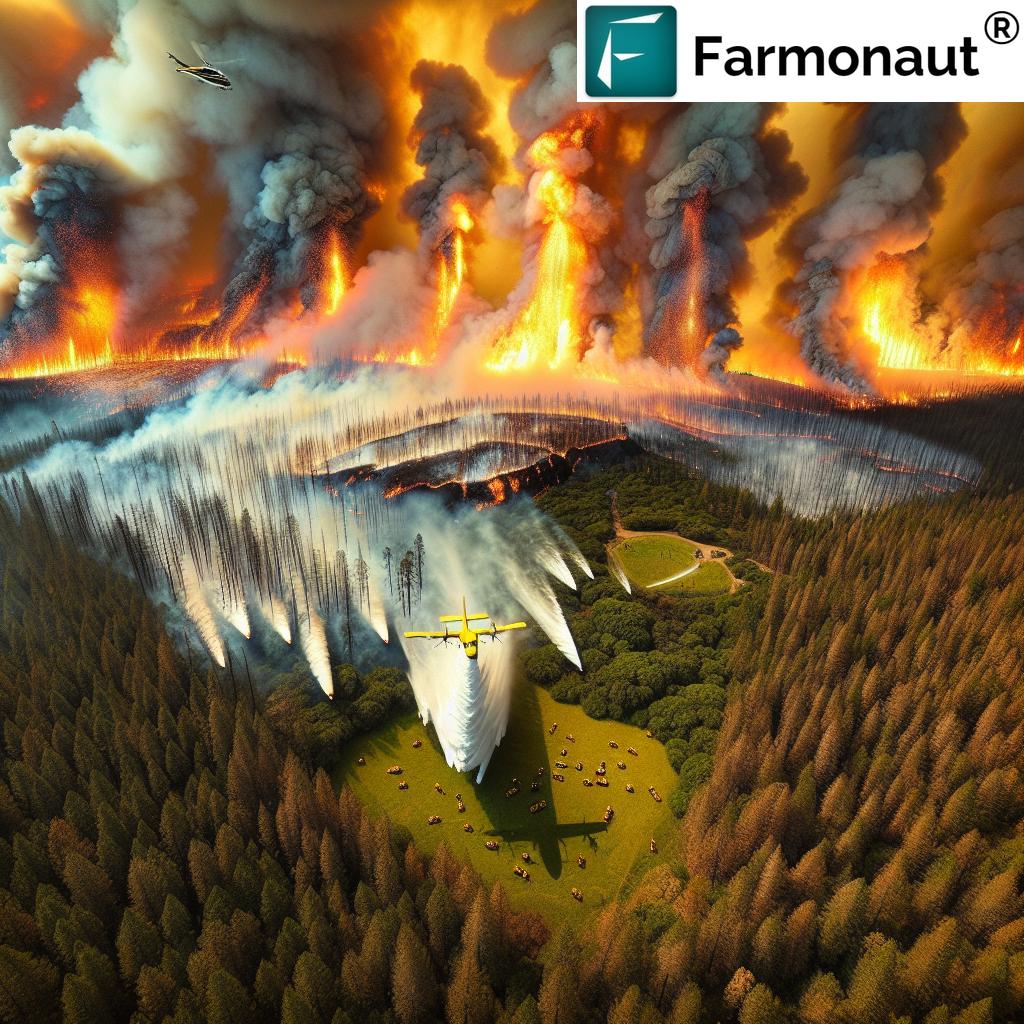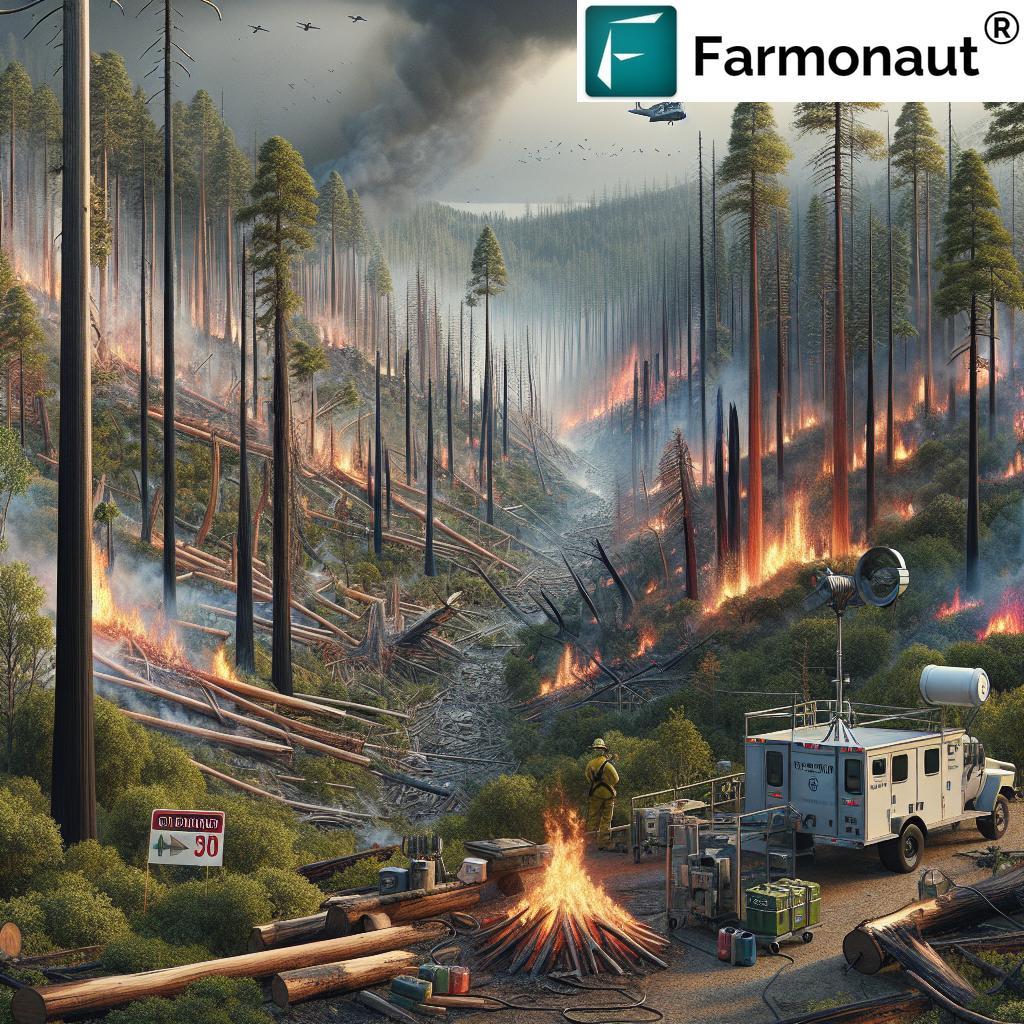North Carolina Wildfires: Critical Updates on Black Cove Complex and Containment Strategies
“The Black Cove Complex wildfires in North Carolina have consumed over 6,000 acres, with 450+ personnel battling the blazes.”
As we at Farmonaut closely monitor the ongoing wildfire situation in North Carolina, we understand the critical importance of staying informed about these devastating events. Our satellite-based monitoring systems have been tracking the progression of these fires, providing valuable insights to authorities and stakeholders. In this comprehensive report, we’ll delve into the latest updates on the Black Cove Complex wildfires, examine the containment strategies being employed, and discuss the wider implications for the region.
Understanding the Black Cove Complex Fires
The Black Cove Complex in North Carolina has become the epicenter of a fierce battle against wildfires that have consumed vast swathes of land. Two major fires within this complex, the Black Cove Fire and the Deep Woods Fire, have collectively burned over 6,000 acres of both state-owned and private land. These fires have posed significant challenges to firefighters and local communities alike.

Black Cove Fire
The Black Cove Fire, burning approximately 2 miles northeast of Saluda in the Green River Gorge, has consumed about 3,410 acres and is currently 23% contained. This blaze, which started on March 19 due to a downed power line, has been fueled by challenging weather conditions and difficult terrain.
Deep Woods Fire
Located about 5 miles northwest of Columbus, the Deep Woods Fire has burned approximately 3,797 acres and is 32% contained. This fire is burning through the Green River Gorge and Holbert Cove community, presenting unique challenges for firefighters due to its location and the surrounding landscape.
Containment Strategies and Firefighting Efforts
The North Carolina Department of Agriculture & Consumer Services, along with various other agencies, has mobilized an impressive force to combat these wildfires. Currently, about 458 personnel are on the ground, working tirelessly to contain the flames and protect nearby communities.
Tactical Approaches
- Black Cove Fire: Crews are prioritizing the southwestern part of Black Cove to secure the firemeter and protect homes in the Skyland Acres area. Overnight operations have focused on clearing unburned fuels between containment lines and the fire area.
- Deep Woods Fire: Firefighters have utilized bulldozers and hand lines near the southeastern portion of the fire by the Green River. Strategic firing operations have been conducted to protect homes along Green River Road.
These wildfire containment strategies showcase the complex nature of fighting such large-scale fires. At Farmonaut, our large-scale management solutions can assist in monitoring vast areas affected by such disasters, providing crucial data for decision-making processes.
Challenges Faced by Firefighters
The firefighting teams are facing numerous obstacles in their efforts to contain these wildfires:
- Low humidity levels
- Strong winds promoting fire spread
- Hurricane-damaged timber creating additional fuel
- Difficult terrain limiting access
- Rapidly changing weather conditions
These challenges underscore the importance of advanced monitoring and prediction tools. Farmonaut’s satellite-based crop health monitoring system, while primarily designed for agricultural use, can be adapted to track vegetation health in wildfire-prone areas, potentially aiding in fire risk assessment and management.
Weather Conditions and Fire Behavior
The weather plays a crucial role in wildfire behavior and containment efforts. Recent conditions in North Carolina have been particularly conducive to fire spread:
- A recently expired Red Flag Warning indicates heightened fire danger
- Rising temperatures and low humidity levels are drying out fuels rapidly
- Strong winds are fanning the flames and carrying embers to new areas
- Hurricane Helene’s impact on forest structure has accelerated fire spread
Our Jeevn AI Advisory System at Farmonaut, while typically used for agricultural forecasting, can provide valuable insights into weather patterns that may affect wildfire behavior. This type of technology could be instrumental in predicting high-risk periods for fire activity.
Environmental Impact and Air Quality Concerns
The wildfires are not only destroying vegetation and wildlife habitats but also significantly impacting air quality in the region. Both Transylvania and Henderson counties are currently under a code purple for air quality, indicating very unhealthy conditions.
“Western North Carolina’s Fish Hook Fire is 95% contained, showcasing progress amidst challenging wildfire conditions in the region.”
While firefighters make progress on some fronts, the air quality situation remains a serious concern. Our carbon footprinting tools at Farmonaut, typically used to help agribusinesses monitor their environmental impact, could be adapted to track the carbon emissions from these wildfires, providing valuable data for environmental assessments.
Community Response and Evacuation Procedures
The safety of local communities is paramount during wildfire events. Several measures have been put in place to protect residents:
- A community meeting was held on March 27 in Saluda to update residents on the wildfire response
- Evacuations are being assessed based on fire activity
- Residents are urged to stay informed through county websites and local news outlets
- A temporary flight restriction is in place from the surface up to 5,500 feet daily until further notice
In situations like these, clear communication and efficient resource management are crucial. Farmonaut’s fleet management solutions, while designed for agricultural operations, could be adapted to assist in coordinating evacuation efforts and managing emergency response vehicles.

Wildfire Prevention Tips
As we continue to monitor the situation, it’s crucial to remember that many wildfires are preventable. Here are some essential wildfire prevention tips:
- Obey burn bans and fire restrictions
- Properly extinguish campfires and cigarettes
- Avoid activities that could create sparks during high-risk periods
- Maintain a defensible space around your property
- Keep gutters and roofs clear of debris
At Farmonaut, we believe that education and prevention are key to reducing wildfire risks. Our crop plantation and forest advisory services could be adapted to provide insights on managing vegetation in wildfire-prone areas, potentially reducing fire risks.
The Role of Technology in Wildfire Management
Advanced technology plays an increasingly important role in wildfire management and prevention. At Farmonaut, we recognize the potential for our agricultural technology to be adapted for wildfire monitoring and management:
- Satellite Imagery: Our satellite-based monitoring systems could be used to track fire spread and identify high-risk areas.
- AI and Machine Learning: These technologies could help predict fire behavior and optimize resource allocation.
- Drone Technology: While not currently part of our offerings, drones could be used for real-time fire mapping and hotspot detection.
- Data Analytics: Advanced analytics could help fire managers make more informed decisions based on real-time data.
While our primary focus at Farmonaut is on agricultural applications, we’re always exploring ways our technology can be adapted to address critical environmental challenges like wildfire management.
Wildfire Status Summary
| Fire Name | Acreage Burned | Containment Percentage | Personnel Involved | Key Challenges |
|---|---|---|---|---|
| Black Cove Fire | 3,410 | 23% | ~200 | Low humidity, strong winds, difficult terrain |
| Deep Woods Fire | 3,797 | 32% | ~200 | Hurricane-damaged timber, complex landscape |
| Fish Hook Fire | 199 | 95% | ~50 | Extinguishing smoldering fuels, securing fire breaks |
Looking Ahead: Future Preparedness
As we continue to monitor the North Carolina wildfires, it’s crucial to consider long-term strategies for wildfire preparedness and prevention. Some key areas of focus include:
- Improved Forest Management: Implementing sustainable forestry practices to reduce fire risks.
- Enhanced Early Warning Systems: Developing more accurate fire prediction models.
- Community Education: Increasing public awareness about fire safety and prevention.
- Infrastructure Resilience: Building and maintaining fire-resistant infrastructure in high-risk areas.
At Farmonaut, we’re committed to exploring how our agricultural technology can contribute to these efforts. Our crop loan and insurance solutions, for instance, could potentially be adapted to help assess and manage wildfire risks in agricultural areas.
Conclusion
The North Carolina wildfires in the Black Cove Complex present a significant challenge to firefighters, local communities, and environmental managers. As we’ve seen, the combination of challenging weather conditions, difficult terrain, and the lingering effects of Hurricane Helene have created a perfect storm for fire spread.
However, the tireless efforts of firefighting teams, coupled with advanced containment strategies and technology, are making a difference. The progress made on the Fish Hook Fire, now 95% contained, offers a glimmer of hope amidst these challenging conditions.
As we at Farmonaut continue to monitor this situation, we’re reminded of the critical importance of environmental management and the potential for agricultural technology to contribute to broader environmental challenges. While our primary focus remains on providing innovative solutions for farmers and agribusinesses, we’re always exploring ways our technology can be adapted to address pressing environmental issues like wildfire management.
We urge all residents in affected areas to stay informed, follow evacuation procedures when necessary, and adhere to fire safety guidelines. Together, through awareness, preparation, and the strategic use of technology, we can work towards a future where the impact of wildfires is minimized, and our natural landscapes are better protected.
FAQ Section
Q: What caused the Black Cove Fire?
A: The Black Cove Fire was reported to have started on March 19 due to a downed power line.
Q: How many acres have been burned in the Black Cove Complex?
A: The Black Cove Complex fires have burned over 6,000 acres combined, with the Black Cove Fire burning approximately 3,410 acres and the Deep Woods Fire burning about 3,797 acres.
Q: What is the current containment status of these fires?
A: As of the latest reports, the Black Cove Fire is 23% contained, the Deep Woods Fire is 32% contained, and the Fish Hook Fire is 95% contained.
Q: How many personnel are involved in fighting these fires?
A: Approximately 458 personnel are on the ground, working to contain the flames and protect nearby communities.
Q: What are the main challenges facing firefighters?
A: The main challenges include low humidity, strong winds, hurricane-damaged timber creating additional fuel, difficult terrain limiting access, and rapidly changing weather conditions.
Q: How has Hurricane Helene impacted the wildfire situation?
A: Hurricane Helene caused significant damage to tree canopies, exposing more ground to direct sunlight. This has led to faster drying of fuels and accelerated fire spread.
Q: What should residents do if they’re in an area affected by the wildfires?
A: Residents should stay informed through county websites and local news outlets, be prepared to evacuate if necessary, and follow all instructions from local authorities.
Q: How can I help prevent wildfires?
A: You can help prevent wildfires by obeying burn bans, properly extinguishing campfires and cigarettes, avoiding activities that could create sparks during high-risk periods, and maintaining a defensible space around your property.
At Farmonaut, we’re committed to leveraging technology for better environmental management. While our focus is on agricultural solutions, we believe that many of our tools and approaches can be adapted to address critical challenges like wildfire management. From our satellite-based monitoring systems to our AI-driven advisory tools, we’re constantly exploring new ways to contribute to a more sustainable and resilient future.
For those interested in learning more about how technology can be applied to environmental challenges, we invite you to explore our range of solutions:
Earn With Farmonaut: Affiliate Program
Earn 20% recurring commission with Farmonaut’s affiliate program by sharing your promo code and helping farmers save 10%. Onboard 10 Elite farmers monthly to earn a minimum of $148,000 annually—start now and grow your income!
Stay informed, stay safe, and let’s work together towards a more resilient and fire-resistant future.
















